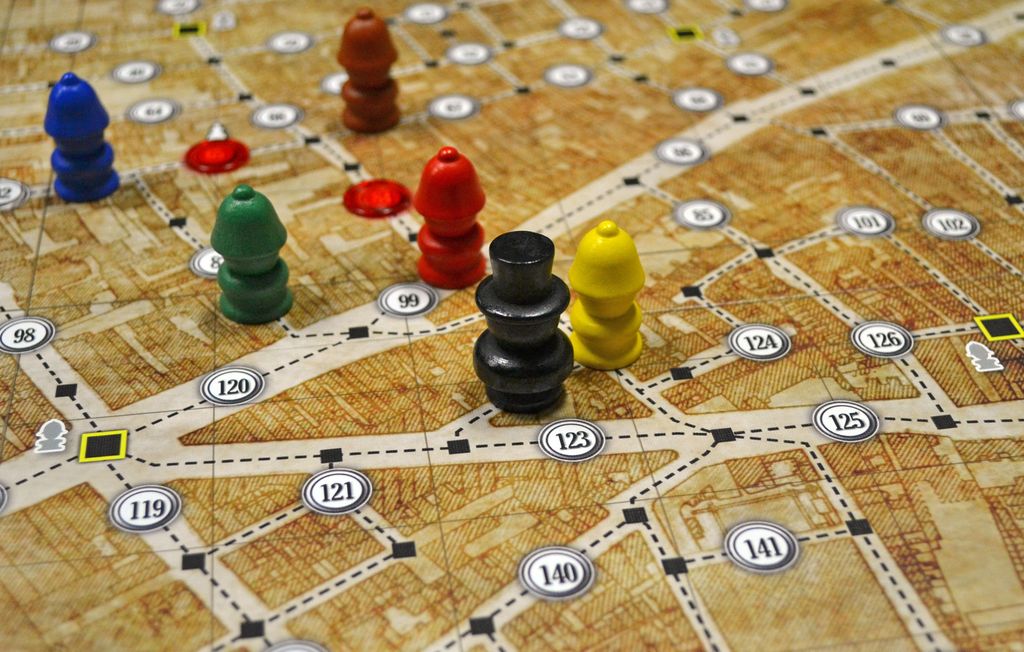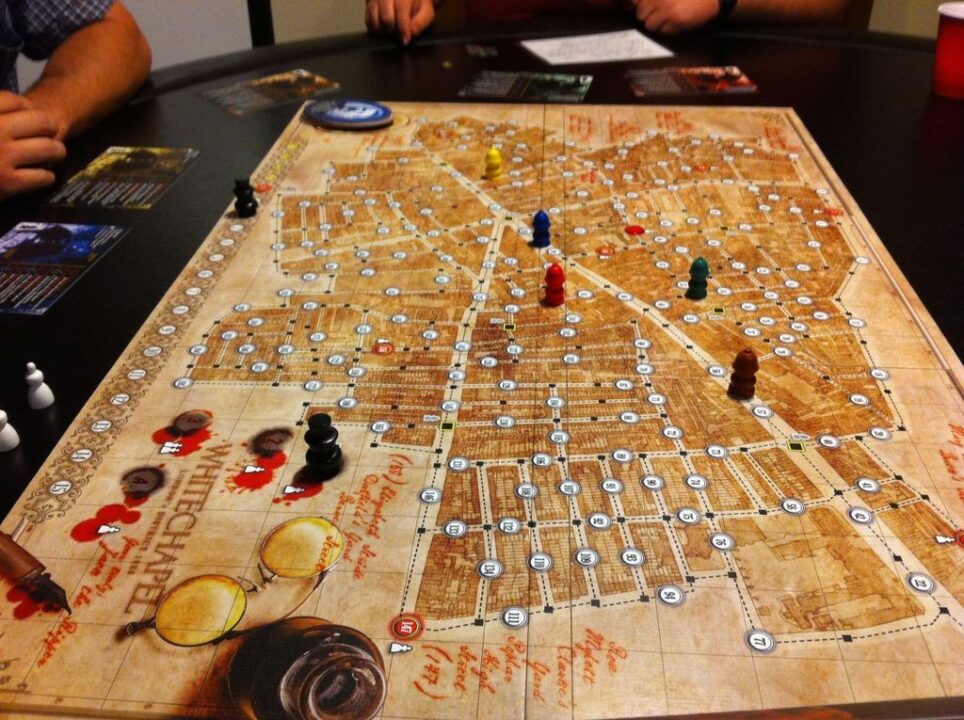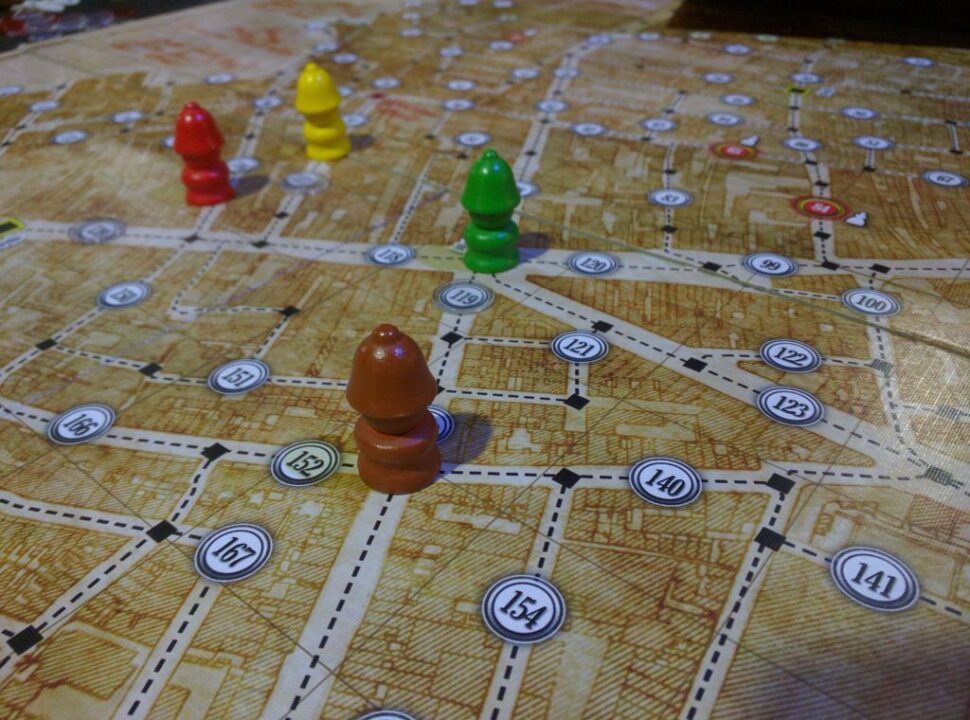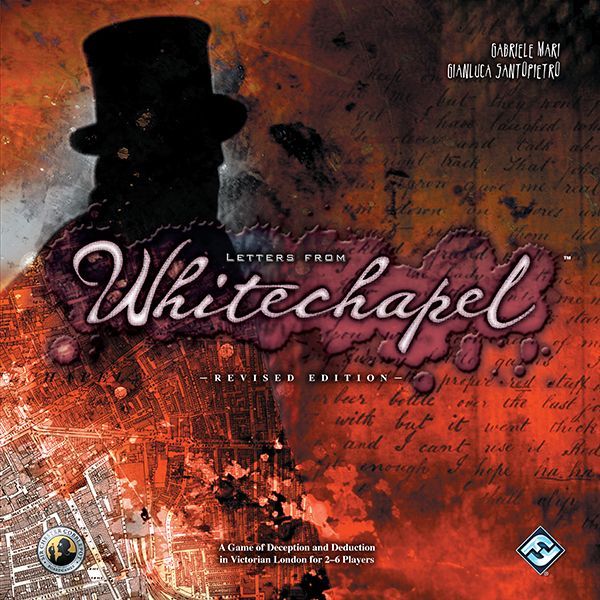Overview
Welcome to the contemplative shadows of Victorian London, as we unravel the enigma at the heart of Letters from Whitechapel in this review. Gird your minds for a gripping game of cat-and-mouse as we dive into the anatomy of an evocative board gaming experience that combines the thrill of hide-and-seek mechanics, the cerebral suspense of social deduction tension, and the rich tapestry of historical setting immersion. This review will balance necessity with intrigue, giving both seasoned detectives and cunning fugitives alike a glimpse into what makes this game a compelling addition to any game night.
How It Plays
Setting Up
In Letters from Whitechapel, you first choose someone to play the infamous Jack the Ripper, with others taking on the roles of detectives. The game board, representing the Whitechapel area of London, is set in front of all players. Jack’s player receives a secret movement pad to track his hidden traverses, while the detectives get their own pawns placed at the police headquarters.
Gameplay
The gameplay is an engaging cat-and-mouse chase. Each round is a night where Jack must commit a crime and then escape to his hideout. Detectives are tactically moving, clamoring to gather clues, staying tantalizingly a step behind or en route to cornering Jack empirically through guesswork and vigorous debates.
Winning the Game
Victory conditions in Letters from Whitechapel derivate from its central hide-and-seek paradigm. If the detectives can ensnare Jack by landing on his current location, they win the game. Meanwhile, Jack must avoid capture for four nights all the while managing to mislead his pursuers, to claim his sinister victory.
Want to know more? Read our extensive strategy guide for Letters from Whitechapel.
The Thrill of the Chase
The ‘Hide-and-seek mechanics’ discussion of Letters from Whitechapel Review immediately brings to mind an intense session I hosted last week. Cat-and-mouse gameplay dictates the pulse of play. On one side, Jack sneakily navigated London’s cobbled streets while, as vigilant officers, we deliberated, deduced, and desperately speculated every possible move. Strategic Misdirection This game nails the constant push-pull of deception and discovery. Often, as Jack’s nearest dangerously.Sadly missed and Intense Final Moments the game ends dramatically with all too many close calls; the mechanics underlying these adrenaline-fueled encounters never grow old.
Moving forward, let’s dissect ‘Social deduction tension’ and its role …

The Thrills of Social Intrigue in Letters from Whitechapel
In my gaming group’s Letters from Whitechapel sessions, the tangible tension of social deduction is second to none. Crafted Suspicion sets the stage, where players pioneer through layers of trust and deceit. What seems like casual chatter often cloaks a scrutinizing analysis of body language and strategy—a true testament to this game’s brilliance. Rapid whispers and sharp glances reminded me in one nail-biting session, no one is above suspicion.
Predictive Maneuvers
The Letters from Whitechapel Review would be incomplete without diving into gameplay twists. Turns morph into a mind-chess affair, a cerebral ballet danced around likely havens of our quarry, Jack. Ever in the detective’s mind: Where will Jack turn next? Ultimately, moving from the exhilarating battle of wits in this section, we inch towards the role of the Historical setting in enriching our immersive experience.

Stepping Back in Time
In my Letters from Whitechapel review, I must highlight the historical setting’s immense role in the whole experience. Playing as either the famed Jack the Ripper or one of the determined detectives, I felt catapulted into the foggy, gas-lit streets of Victorian London. The game’s creators achieved a remarkable feat in creating an atmosphere thick with period tension. Anecdotally, one session had us cease banter, listening instead to clinking carriage wheels and muffled steps from the game’s ambient soundtrack, chasing shadows across the beautifully rendered board.
Victorian London Reimagined
The thematic fidelity continues with game components and art that drip with historical reverence. The detailed map accurately reflects Whitechapel’s layout, thus, likewise, the period’s dark palls hangs heavy over avid gamers’ strategies. There’s this natural feeling that one wrong step can reverberate through the cobblestones of history, adding weight to every decision.
In The Ripper’s Shadow
Moreover, the character cards supplement our endeavor through narratives intertwined with historical facts—an underestimated tool. As I delved into the personas, the factual reference points, an affinity developed, a closeness that you’d seldom expect between player and game—the attachment akin to a historical novel protagonist.
I can look past minor meandering visually, as it’s the potent authenticity where Whitechapel triumphs; its historical essence doesn’t just supplement—it transcends gameplay. It earns my recommendation both for its intriguing mechanics and the immersive Tudor trip.

Conclusion
Concluding this Letters from Whitechapel review, I am swept away by the juxtaposition of its ingeniously simple hide-and-seek mechanics with the pulse-pounding social deduction tussle it incites. The game not only succeeds in consistently delivering nail-biting moments but also submerges players into the grim historical backdrop of Victorian London with ease. Whether you revel in outsmarting your opponents in a battle of wits or prefer the immersive experience of a thematic period piece, Letters from Whitechapel stands out as a worthy contender on any game night. In sum, it’s a game I unreservedly recommend for those who appreciate strategy, social elements, and historical contexts deftly woven into their board gaming sessions.


